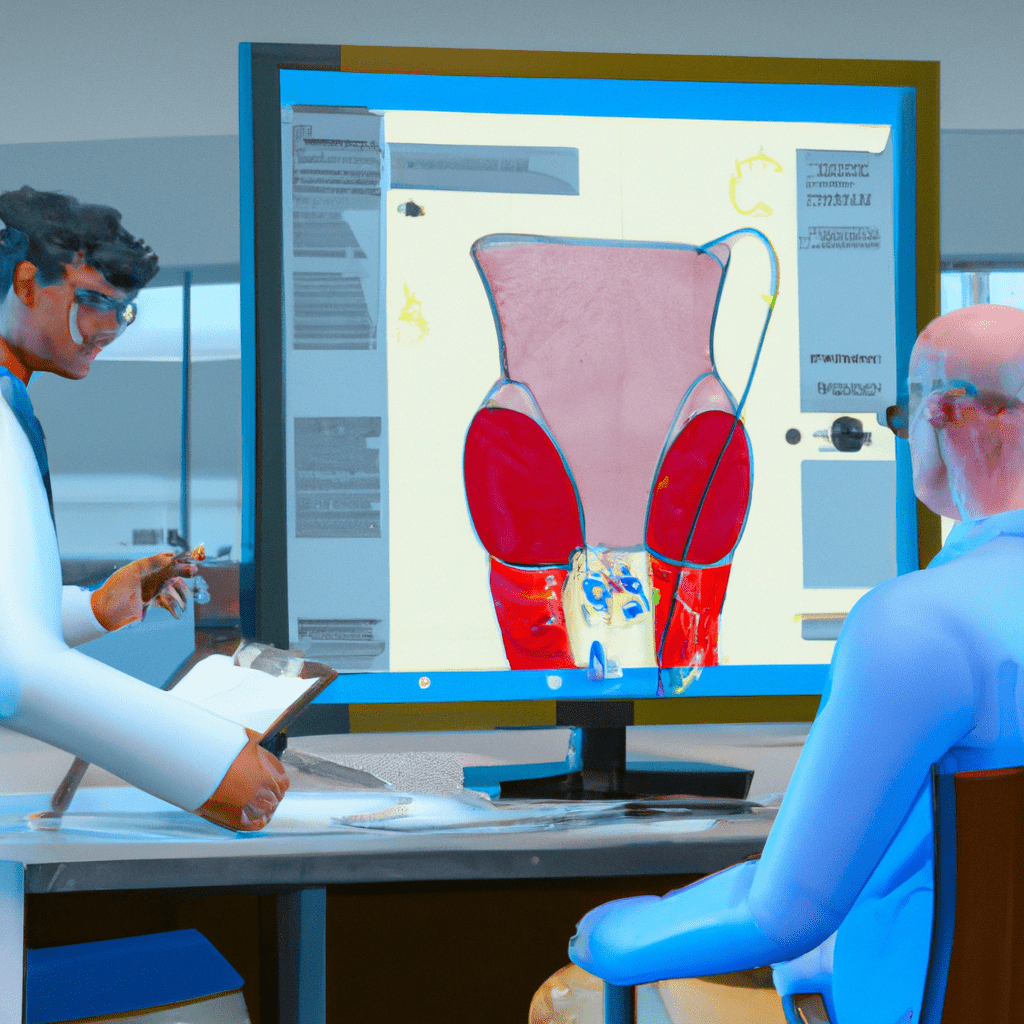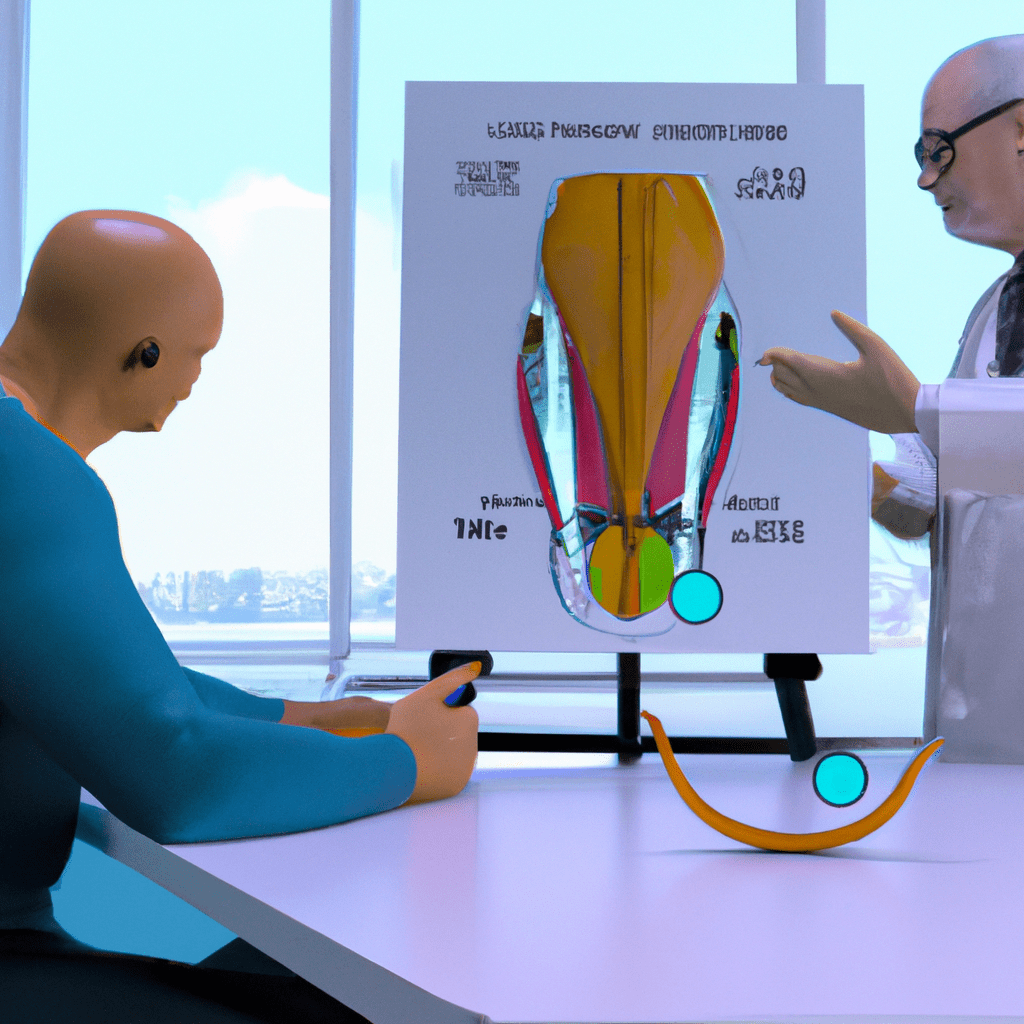Prostate cancer is a significant health concern for men worldwide. It is the second most common cancer among men and, if not detected and treated early, can lead to severe health complications and even death[4].
One of the critical tools in the early detection and diagnosis of prostate cancer is a prostate biopsy. This procedure allows doctors to examine tissue samples from the prostate gland to identify the presence of cancerous cells and determine the severity of the disease.
In this comprehensive guide, we will delve deeper into the prostate biopsy procedure, discussing its importance, the reasons for performing a biopsy, the various methods used, and the diagnosis and treatment planning process.
Additionally, we will provide insights on preparing for a prostate biopsy, what to expect during and after the procedure, and some potential risks and alternatives to consider.
Contents
- 1 What is a Prostate Biopsy? A Detailed Look into the Diagnostic Procedure
- 2 Reasons for a Prostate Biopsy: Indications and Factors Leading to the Procedure
- 3 Diagnosing Prostate Cancer: A Comprehensive Overview of the Process
- 4 Determining the Aggressiveness of Prostate Cancer: Key Factors and Considerations
- 5 Preparing for a Prostate Biopsy: Steps and Recommendations
- 6 The Procedure of a Prostate Biopsy: A Step-by-Step Guide
- 7 Prostate Biopsy Recovery: Tips and What to Expect
- 8 Importance of Meticulous Labeling of Biopsy Specimens: Ensuring Accurate Diagnosis and Treatment
- 9 Alternatives to Prostate Biopsy: Emerging Techniques and Diagnostic Tools
- 10 Conclusion: Understanding the Importance of Prostate Biopsy and Exploring Emerging Alternatives
- 11 Frequently Asked Questions about Prostate Biopsy
- 12 Reference
- 13 Men's Health Related Articles
What is a Prostate Biopsy? A Detailed Look into the Diagnostic Procedure
A prostate biopsy is a medical procedure involving collecting small tissue samples from a man’s prostate gland to detect prostate cancer[1]. The prostate gland is essential to the male reproductive system, producing fluid that nourishes and transports sperm. It is a small, walnut-shaped gland below the bladder and in front of the rectum[2].
During a prostate biopsy, a doctor uses a thin, hollow needle to extract tissue samples from various regions of the prostate gland. These samples, known as “cores,” are then sent to a laboratory and examined under a microscope by a pathologist. The pathologist looks for any abnormal cell growth, which may indicate the presence of cancer.
There are several prostate biopsy methods, but the most common is the transrectal ultrasound (TRUS)-guided method[3]. In this technique, the doctor inserts a probe into the rectum, which emits ultrasound waves to create a real-time image of the prostate gland on a monitor. This image assists the doctor in accurately guiding the biopsy needle into the targeted areas of the prostate gland. Local anesthesia is often administered to minimize discomfort during the procedure.
Other biopsy methods include the transperineal approach, where the biopsy needle is inserted through the skin between the anus and scrotum, and the transurethral approach, where the biopsy is performed through the urethra using a cystoscope. These methods may be used in specific situations or when the transrectal way is unsuitable for a patient.
A prostate biopsy is an essential diagnostic tool in the early detection of prostate cancer, helping doctors identify the presence of cancer, determine its aggressiveness, and develop an appropriate treatment plan tailored to the individual patient’s needs.
Reasons for a Prostate Biopsy: Indications and Factors Leading to the Procedure

A prostate biopsy is performed when there is a suspicion of prostate cancer due to specific indicators, such as abnormal results from screening tests or physical examination findings. Here, we discuss some of the primary reasons for conducting a prostate biopsy:
Elevated PSA levels: Prostate-specific antigen (PSA) is a protein produced by the prostate gland. When PSA levels are elevated, it may indicate the presence of prostate cancer or other prostate-related conditions. If a blood test reveals high PSA levels, a doctor may recommend a prostate biopsy to determine if cancer is present[7].
Abnormal digital rectal exam (DRE): During a DRE, a doctor inserts a lubricated, gloved finger into the rectum to examine the prostate gland for any abnormalities, such as lumps, problematic areas, or unusual texture. If the DRE reveals any potential concerns, the doctor may recommend a prostate biopsy further to investigate the possibility of cancer[7].
Active surveillance: In some cases, men with low-risk prostate cancer may choose active management, which involves closely monitoring cancer without immediate treatment. During active surveillance, periodic prostate biopsies may be performed to track any changes in cancer and ensure it has not progressed to a more aggressive stage that would require intervention[6].
Abnormal imaging results: Advanced imaging techniques, such as multiparametric magnetic resonance imaging (mpMRI), can provide detailed information about the prostate gland and identify areas of concern. If imaging results reveal suspicious areas, a doctor may recommend a targeted prostate biopsy to collect tissue samples from those regions for further analysis.
Previous negative biopsy with persisting suspicion: In some cases, a patient may have had a prior negative biopsy, meaning no cancer was found, but their PSA levels continue to rise, or other clinical factors suggest the presence of cancer. In these situations, a doctor may recommend a repeat biopsy to ensure no cancer is missed during the initial procedure.
It is important to note that not all men with elevated PSA levels or abnormal DRE findings will have prostate cancer. Other conditions, such as prostatitis (prostate inflammation) or benign prostatic hyperplasia (BPH, an enlarged prostate), can also cause these abnormalities. However, a prostate biopsy is a crucial diagnostic tool for ruling out or confirming the presence of cancer and guiding appropriate treatment decisions.
Diagnosing Prostate Cancer: A Comprehensive Overview of the Process
Diagnosing prostate cancer involves a series of tests and examinations to detect the presence and extent of cancer in the prostate gland. The diagnostic process typically includes the following steps:
Screening: Prostate cancer screening usually involves a blood test to measure prostate-specific antigen (PSA) level and a digital rectal examination (DRE). Elevated PSA levels and abnormal DRE findings may raise suspicion of prostate cancer. Still, these tests alone are not definitive for diagnosing the disease, as other prostate conditions can also cause these abnormalities[7].
Imaging: If screening tests suggest the possibility of prostate cancer, a doctor may recommend imaging tests, such as transrectal ultrasound (TRUS) or multiparametric magnetic resonance imaging (mpMRI). These imaging techniques provide detailed information about the prostate gland’s structure and can help identify suspicious areas requiring further investigation[4].
Prostate biopsy: A prostate biopsy is the definitive diagnostic tool for detecting prostate cancer. During this procedure, a doctor collects tissue samples from various regions of the prostate gland using a thin, hollow needle. These samples are then sent to a laboratory, where a pathologist examines them under a microscope to determine the presence of cancer cells[1].
Gleason score and Grade Group: The pathologist will assign a Gleason score based on the cancer cells’ appearance and pattern if cancer is found in the biopsy samples. The Gleason score and other factors are used to determine cancer’s aggressiveness and categorize it into a Grade Group. The Grade Group system ranges from 1 (least aggressive) to 5 (most aggressive) and helps guide treatment decisions[6].
Staging: To determine the extent of prostate cancer and whether it has spread beyond the prostate gland, additional tests may be performed, such as bone scans, computed tomography (CT) scans, or positron emission tomography (PET) scans. The information from these tests helps doctors assign a cancer stage, which ranges from Stage I (localized and least advanced) to Stage IV (most advanced and metastatic). Staging is critical in developing an appropriate treatment plan for the patient.
Genomic testing: In some cases, genomic testing may be conducted on the biopsy samples to assess cancer’s genetic characteristics. This information can provide insights into cancer’s behavior, potential aggressiveness, and responsiveness to specific treatments.
After diagnosing prostate cancer, a healthcare team will discuss the results with the patient and develop a personalized treatment plan based on cancer’s characteristics, stage, and the patient’s overall health and preferences. Treatment options may include active surveillance, surgery, radiation therapy, hormone therapy, chemotherapy, immunotherapy, or a combination of these approaches.
Determining the Aggressiveness of Prostate Cancer: Key Factors and Considerations
The aggressiveness of prostate cancer is a critical factor in deciding the most appropriate treatment plan for a patient. Healthcare professionals assess several aspects to determine cancer’s aggressiveness, including:
Gleason score: The Gleason score is based on the appearance and pattern of cancer cells in the biopsy samples, as observed by a pathologist under a microscope. The Gleason score ranges from 2 (least aggressive) to 10 (most aggressive). A higher Gleason score indicates a higher likelihood of cancer growing and spreading quickly[6].
Grade Group: The Grade Group system is another way to categorize the aggressiveness of prostate cancer. It considers the Gleason score and other factors, assigning the tumor to a Grade Group from 1 (least aggressive) to 5 (most aggressive). Lower Grade Group cancers are less likely to grow and spread, while higher Grade Group cancers are more aggressive and require more intensive treatment[6].
Prostate-specific antigen (PSA) level: A higher PSA level in the blood may indicate more aggressive cancer. However, PSA levels alone cannot definitively determine cancer aggressiveness, as other factors can also cause elevated PSA levels.
Cancer stage: The cancer stage reflects the extent of cancer, including its size and whether it has spread beyond the prostate gland. The sets range from Stage I (localized and least advanced) to Stage IV (most advanced and metastatic). Advanced-stage cancers are generally more aggressive and require more intensive treatment.
Genomic testing: In some cases, genomic testing may be conducted on the biopsy samples to assess cancer’s genetic characteristics. This information can provide insights into cancer’s behavior, potential aggressiveness, and responsiveness to specific treatments.
The rate of growth of cancer, or how quickly it is increasing in size or spreading, can also indicate its aggressiveness. Doctors may monitor the growth rate by comparing multiple PSA tests and biopsy results.
After evaluating these factors, the healthcare team will develop a personalized treatment plan based on the aggressiveness of cancer and the patient’s overall health and preferences. Less aggressive cancers may be managed with active surveillance, while more aggressive cancers typically require more intensive treatment options, such as surgery, radiation therapy, hormone therapy, chemotherapy, or immunotherapy.
Preparing for a Prostate Biopsy: Steps and Recommendations
A prostate biopsy is an essential diagnostic procedure to confirm the presence of prostate cancer. Adequate preparation can help ensure a smooth process and minimize the risk of complications. Here are some steps and recommendations for preparing for a prostate biopsy:
Discuss with your doctor: Before the procedure, discuss any concerns, questions, or expectations you have with your doctor. They will provide information about the process, its risks, and its benefits. Make sure to inform your doctor about any medications you are taking, including blood thinners, aspirin, supplements, and any allergies or medical conditions you have[7].
Medication adjustments: Your doctor may ask you to stop taking certain medications, such as blood thinners or aspirin, several days before the biopsy. These medications can increase the risk of bleeding during the procedure. Always follow your doctor’s instructions regarding medication adjustments[9].
Antibiotics: Your doctor may prescribe antibiotics to be taken before and after the biopsy to reduce the risk of infection. Follow the prescribed course and dosage as instructed[7].
Bowel preparation: Sometimes, your doctor may recommend using an enema or a laxative the day before the biopsy to empty your bowels. A clean rectal area can help minimize the risk of infection during the procedure[9].
Fasting: Your doctor may advise you to refrain from eating or drinking for a specific period before the biopsy. This is particularly important if you are sedated during the procedure[7].
Arrange for transportation: As you may feel some discomfort or be under the influence of sedation after the biopsy, it is advisable to have someone drive you home following the procedure.
Recovery plan: After the biopsy, you may experience discomfort, bleeding, or urinary symptoms. Prepare your home environment and arrange some time off work or daily activities to rest and recover. Stock up on essential items, such as pain relievers and sanitary pads, to manage post-procedure symptoms.
By following these steps and recommendations, you can better prepare for a prostate biopsy and ensure a smoother procedure and recovery process. Always communicate with your healthcare team and follow their guidance to optimize your experience and outcomes.
The Procedure of a Prostate Biopsy: A Step-by-Step Guide
A prostate biopsy is a necessary procedure in diagnosing prostate cancer. Several methods can be used to perform a prostate biopsy, but the most common is the transrectal ultrasound (TRUS)-guided biopsy. In this section, we will discuss the step-by-step procedure for a TRUS-guided prostate biopsy:
Preparation: Before the biopsy, the patient may be asked to undergo some preparatory steps, such as taking antibiotics to minimize infection risk, using an enema to clear the rectum, and possibly refraining from certain medications that could increase the risk of bleeding[9].
Positioning: On the day of the procedure, the patient will be positioned on their side on an examination table, with their knees drawn up toward the chest. Alternatively, the patient may be asked to lie on their back with their legs raised and supported in stirrups.
Local anesthesia: To minimize discomfort, the doctor will administer local anesthesia through a numbing gel or an injection around the prostate area[3].
Insertion of the ultrasound probe: The doctor will insert a lubricated ultrasound probe into the patient’s rectum. The probe emits ultrasound waves, creating real-time prostate gland images on a monitor. This helps the doctor visualize the gland and accurately target specific areas for biopsy.
Biopsy needle insertion: A spring-loaded biopsy needle is inserted through a needle guide attached to the ultrasound probe. With the help of ultrasound images, the doctor will carefully guide the hand into the targeted areas of the prostate gland and extract small tissue samples, or “cores.” Typically, 10 to 12 cores are collected from different gland regions to ensure a thorough examination[1].
Tissue sample processing: The collected tissue samples are placed into separate, labeled containers and sent to a laboratory for analysis by a pathologist. The pathologist examines the examples under a microscope to determine the presence of cancer cells and, if present, the aggressiveness of the cancer.
Post-procedure care: After the biopsy, the patient may experience some discomfort, such as mild pain, blood in the urine, semen, or stool, and possibly temporary difficulty urinating. These side effects are usually short-lived and can be managed with over-the-counter pain medication and proper care[10]. The patient should follow their doctor’s recommendations for post-biopsy care and report any concerning symptoms, such as fever or severe pain.
The biopsy results are typically available within a few days to a week. After that, the doctor will discuss the findings and recommend any necessary next steps in the patient’s care. The procedure usually takes about 10 to 20 minutes, and the patient can often return home on the same day.
Prostate Biopsy Recovery: Tips and What to Expect
After a prostate biopsy, patients typically experience a relatively short recovery period. Here’s what to expect during recovery and some tips to help you heal:
Rest: Following the biopsy, getting ample rest is essential to help your body recover. Avoid strenuous activities and heavy lifting for a few days after the procedure[10].
Bleeding: Some bleeding is common after a prostate biopsy, especially in the first 24-48 hours. You may notice blood in your urine, stool, or semen. This should gradually improve and resolve within a few days to a week. If the bleeding persists or worsens, contact your doctor[10].
Pain relief: You may experience some discomfort or pain after the biopsy. Over-the-counter pain relievers, such as acetaminophen, can help manage the pain. Avoid taking aspirin, as it may increase the risk of bleeding. Follow your doctor’s recommendations for pain management[10].
Drink fluids: Drinking plenty of water can help flush blood from your urinary system and reduce the risk of urinary tract infections[10].
Monitor for infection: Monitor for signs of infection, such as fever, chills, increased pain, or discharge from the biopsy site. If you suspect an infection, contact your doctor immediately.
Follow-up: Your doctor will schedule a follow-up appointment to discuss the biopsy results and any necessary next steps. Attend this appointment and ask any questions or share your concerns.
Resuming normal activities: Most patients can resume their normal activities within a few days to a week after the biopsy. However, following your doctor’s advice on when to return to work, exercise, and other activities is crucial.
Following these tips and your doctor’s recommendations can ensure a smoother recovery process after your prostate biopsy. If you experience any complications or concerns during your recovery, don’t hesitate to contact your healthcare team for guidance and support.
Importance of Meticulous Labeling of Biopsy Specimens: Ensuring Accurate Diagnosis and Treatment

Accurate labeling of prostate biopsy specimens is crucial for several reasons. Proper labeling ensures precise diagnosis, appropriate treatment plans, and effective communication among healthcare providers. Here’s why detailed labeling is so important:
Accurate diagnosis: Each biopsy sample or “core” taken from different areas of the prostate gland can provide valuable information about prostate cancer’s presence, extent, and aggressiveness. Proper labeling helps the pathologist identify the specific location of each core and accurately assess cancer’s characteristics and spread[9].
Personalized treatment plans: An accurate diagnosis based on labeled biopsy specimens allows healthcare providers to develop a customized treatment plan tailored to the patient’s specific cancer characteristics and overall health. The treatment plan may include active surveillance, surgery, radiation therapy, hormone therapy, chemotherapy, or immunotherapy, depending on cancer’s aggressiveness, location, and stage.
Tracking cancer progression: Meticulous labeling enables healthcare providers to track changes in cancer over time, particularly if a patient undergoes multiple biopsies. This information is essential for monitoring cancer’s progression and adjusting the treatment plan.
Effective communication: Properly labeled biopsy specimens facilitate precise and accurate communication among healthcare providers involved in the patient’s care. This ensures that all team members comprehensively understand the patient’s condition, which is crucial for coordinating care and making informed decisions.
Reducing errors: Meticulous labeling minimizes the risk of errors, such as misdiagnosis or incorrect treatment recommendations, which could have severe consequences for the patient.
Find out if the physician performing the biopsy will place each core in a separate, labeled container or if another labeling method will be used[9]. Patients should discuss the labeling process with their healthcare provider before the biopsy to ensure detailed labeling. By advocating for proper labeling and maintaining open communication with your healthcare team, you can help ensure an accurate diagnosis and the most effective treatment plan for your prostate cancer.
Alternatives to Prostate Biopsy: Emerging Techniques and Diagnostic Tools
While a prostate biopsy remains the most definitive method for diagnosing prostate cancer, several emerging alternatives may help reduce the need for this invasive procedure. Some of these alternatives include:
Multiparametric MRI (mpMRI): Multiparametric MRI combines multiple imaging techniques to provide a detailed view of the prostate gland. MpMRI can help identify areas of the prostate that are more likely to contain cancerous tissue, potentially reducing the need for biopsy in some cases or guiding a targeted biopsy in others[8].
Prostate Health Index (PHI): The Prostate Health Index is a blood test that combines measurements of total PSA, free PSA, and an additional protein called [-2]proPSA. The PHI provides a more accurate assessment of prostate cancer risk than the traditional PSA test alone, helping to reduce the number of unnecessary biopsies.
4Kscore Test: The 4Kscore Test is a blood test that measures four different prostate-derived proteins (Total PSA, Free PSA, Intact PSA, and Human Kallikrein 2) to estimate a man’s risk of developing aggressive prostate cancer. This test may help guide the decision to perform a biopsy or continue with active surveillance.
PCA3 Test: The PCA3 test is a urine test that measures the level of a prostate cancer-associated gene known as PCA3. This test can be handy for men with a negative biopsy but persistently elevated PSA levels. A high PCA3 score may prompt a repeat biopsy, while a low score could reduce the need for another biopsy.
ConfirmMDx: ConfirmMDx is a genomic test that analyzes the DNA methylation patterns in prostate tissue obtained during a previous negative biopsy. This test helps identify men who may have a false-negative biopsy result and require further testing or a repeat biopsy.
SelectMDx: SelectMDx is a urine test that measures the expression of two genes associated with aggressive prostate cancer. It can help determine the need for a prostate biopsy in men with an elevated PSA level or other risk factors.
These emerging diagnostic tools and techniques can help healthcare providers better determine the need for a prostate biopsy, reducing the number of unnecessary biopsies and their associated risks. However, it is essential to note that these alternatives may only suit some patients. The decision to use them should be made in consultation with a healthcare provider[8].
Conclusion: Understanding the Importance of Prostate Biopsy and Exploring Emerging Alternatives
A prostate biopsy is a crucial diagnostic tool for detecting prostate cancer, allowing healthcare providers to assess the disease’s presence, extent, and aggressiveness. It is typically performed when there is an elevated PSA level or an abnormal digital rectal exam result. The procedure involves removing small tissue samples from the prostate gland for examination under a microscope.
While a prostate biopsy remains the most definitive method for diagnosing prostate cancer, emerging diagnostic tools and techniques can help determine the need for a biopsy, potentially reducing the number of unnecessary biopsies and their associated risks. These alternatives include multiparametric MRI, Prostate Health Index (PHI), 4Kscore Test, PCA3 Test, ConfirmMDx, and SelectMDx.
Patients must be well-informed about the biopsy procedure, its risks, and the importance of detailed labeling of biopsy specimens. Additionally, patients should discuss potential alternatives to a prostate biopsy with their healthcare providers to determine the most suitable approach for their unique circumstances.
Frequently Asked Questions about Prostate Biopsy
Is a prostate biopsy painful?
While a prostate biopsy may cause discomfort, it is not considered painful. Local anesthesia is often used to numb the area, and you may be given medication to help you relax during the procedure[5].
How long does it take to get results from a prostate biopsy?
It usually takes about a week to receive the results from a prostate biopsy, though this timeframe may vary depending on the laboratory and healthcare provider[7].
Can I return to work immediately after a prostate biopsy?
Most people can return to work within a few days, but it’s essential to follow your healthcare provider’s recommendations regarding when to resume work and other activities[10]. Taking it easy and resting for a day or two after a prostate biopsy is generally recommended.
What are the risks associated with a prostate biopsy?
Some risks associated with a prostate biopsy include bleeding, infection, difficulty urinating, and temporary erectile dysfunction. While these side effects are generally short-term, it’s essential to discuss the potential risks and benefits with your healthcare provider before undergoing the procedure[10].
Are there any alternatives to a prostate biopsy for diagnosing prostate cancer?
Several emerging diagnostic tools and techniques, such as multiparametric MRI, Prostate Health Index (PHI), 4Kscore Test, PCA3 Test, ConfirmMDx, and SelectMDx, may help determine the need for a prostate biopsy. However, these alternatives may not be suitable for every patient, and the decision to use them should be made in consultation with a healthcare provider[8].
Reference
1.https://en.wikipedia.org/wiki/Prostate_biopsy
2.https://www.mayoclinic.org/tests-procedures/prostate-biopsy/about/pac-20384734
3.https://www.hopkinsmedicine.org/health/treatment-tests-and-therapies/prostate-biopsy
4.https://www.webmd.com/prostate-cancer/what-is-prostate-biopsy
5.https://www.medicalnewstoday.com/articles/317601
6.https://www.mayoclinic.org/diseases-conditions/prostate-cancer/diagnosis-treatment/drc-20353093
7.https://www.verywellhealth.com/the-prostate-biopsy-what-to-expect-2782256
8.https://www.healthline.com/health/prostate-cancer/prostate-biopsy-procedure
10.https://www.healthline.com/health/prostate-cancer/prostate-biopsy-recovery












